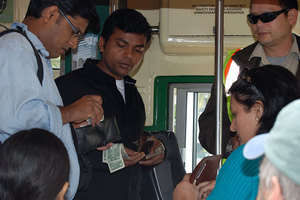Another sordid Saturday morning on the F-line. Eleven a.m., Ferry Building, Wharf-bound. A mob of people waiting as Birmingham 1077 pulls up (see, some of those Newark streetcars DO run!). It’s already packed, but the operator squeezes a few more people in. Then he can’t get the rear doors closed because a passenger is standing on the door-opening treadle and apparently doesn’t understand English (a WHOLE lot of those folks, Europeans, on the line today).

Meantime, his follower, Muni 1051 is waiting behind him with about half a seated load. He’s signed for Pier 39, but no one notices. The operator is helpful, standing up out of his seat as he loads people as efficiently as he can. But with no signage at the crowded stop telling people what the fare is, many people wait till they get to the operator before going into their pockets. I check the Ferry Building clock…1051 has been at the stop FIVE minutes and counting, with about a third of the crowd still to load.
At this point, 1062 pulls up behind, signed for the Wharf. I ask 1051’s operator if he’s really turning at Pier 39. He says yes. I tell the people still in the queue to take the next streetcar if they’re going to the Wharf, then help load them. Almost seven minutes after it arrives at the Ferry, 1051 finally leaves.
For years now, Market Street Railway has advocated for light-duty operators to serve as loaders here, or prepaid ticket machines, or better signage, or SOME kind of crowd-handling improvements. We’ll be talking with Muni about this again in the coming week. Ignoring the problem is clearly not working!
So the person selling tickets at Jones and Beach is a operator?
If memory serves correctly, back in the “nothing but PCC” days, Muni did just as suggested. Loaders would be at the busy stops during afternoon rush. They had change makers and hand-operated registers, and they’d stand by the rear doors. As soon as everyone was aboard (or the car was stuffed), they’d whack the side of the streetcar twice, giving the “highball” to the operator. Very low-tech, and no consultant collected a big fee for suggesting it. Nowadays, workers might be reluctant to stand around with all that money to temp the local bad guys–the “risk exposure” wasn’t as great when the fare was 15 cents.